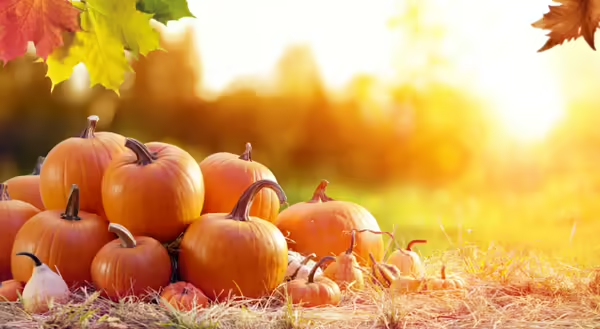
After a long summer tending to your garden, you may be getting a little tired. However, if you want your pumpkins and other winter squash to last well past the growing season, take special care when bringing them in this fall. If you intend to keep your pumpkins around for a while and use them later this year, keep reading!
The primary goal of food preservation, whether canning, freezing or dry storage, is to prevent food from spoiling before it can be consumed. Therefore, if you want your pumpkins to last, you must take steps to avoid spoilage.
However, preventing spoilage and other harmful microorganisms from growing to unsafe numbers on produce stored for the winter can be challenging. Especially because molds, yeasts, and other organisms are naturally found all around us. Nonetheless, if done correctly, pumpkins and other winter squash can be stored for two to six months, depending on the variety.
Harvesting Your Pumpkins
Before we can talk about storing our pumpkins, we first need to discuss harvesting your treasures. There are over 45 different varieties of pumpkins, ranging in color from green to orange, red, and yellow! Thus, you cannot rely on the color to tell if your pumpkin is ready to be brought in. Instead, physically inspect the pumpkin. When pumpkins are ready for harvesting, the stem will be dry, and the rind or the outer skin will be hard and not easily dented or punctured by a fingernail.
Although the rind will be hard, you still need to be careful when handling pumpkins to prevent them from becoming bruised, scratched, or cut until you are ready to use them. If there is any opening in the rind, such as a scratch, microorganisms and other bacteria can enter the pumpkin, which can lead to spoilage.
Pumpkins are generally not damaged by a light frost, especially when the daytime temperatures are warm. However, you will want to harvest them before the temperature drops below freezing to prevent chilling injuries, which – you guessed it, can lead to early spoilage.
Look for a pumpkin with 1 to 3 inches of stem left. The stem should be hard, dry, and dark green or black. If the stem is cut too low, the pumpkin will decay quickly or may already have already begun to spoil. When handling your pumpkin, do NOT carry it by the stem. The stem is NOT intended to be a handle. Once the stem breaks off, that section of the pumpkin becomes exposed, increasing the chance of your pumpkin spoiling early.
Curing Your Pumpkin
Most pumpkins bought in the grocery store have already been cured. However, if you grow your own or purchase them at a farmers’ market, you should consider curing them, especially if you plan on storing them to use later.
Curing is the process of storing your pumpkin at a warm temperature, between 80-85 degrees F, with good air circulation and relative humidity of 80-85 %, for 10–14 days. The curing process will help to harden the pumpkin’s skin and heal any cuts and scratches. It also concentrates the natural sugars, making it taste sweeter. Best of all, it reduces the chance of spoilage before you can use it. Another nice thing about curing pumpkins is you can do it either outside or inside, so you can take advantage of the great fall weather.
Tips for Storing Your Pumpkins
During storage, the pumpkin color may become dull due to aging. However, this does not mean your pumpkin quality has decreased; in fact, in some varieties, the sugar content may actually increase.
- Store whole, unblemished pumpkins in a cool dark location, between 50-60°F. If the temperature drops below freezing, the cell walls within the pumpkin will expand and collapse, resulting in a watery mess when the pumpkin thaws. If the temperature is too warm, it will promote the growth of microorganisms.
- The ideal relative humidity for storage is 50-70%. If the air is too dry, it will cause the pumpkin to shrink faster, and if too high, it will promote spoilage.
- Do not store pumpkins in piles or directly on the floor. Instead, place them in a single row off the floor to allow for good air circulation. If pumpkins are stored too close together, the heat generated by the other pumpkins may lead to rotting. And if pumpkins are stored directly on the floor, the moisture from the floor, combined with the moisture from the pumpkins, will promote spoilage. If you must store pumpkins on the floor, place them on a porous surface, such as cardboard, an old rug, straw, or wood, to help prevent spoilage.
- Do not store pumpkins or winter squash near apples, pears, or other ripening fruits. This will shorten their storage life due to the release of ethylene gas produced by the other ripening fruit.
When bringing your pumpkin or winter squash out of storage, wash them thoroughly before cutting or cooking. Clean with running water and a good vegetable brush; there is no need to use soap. Finally, enjoy your tasty pumpkin, whether baking a dessert or using it in soup or a casserole.
Source: Diane Reinhold, MPH, MS, RDN Nutrition and Wellness Educator serving Jo Daviess, Stephenson & Winnebago Counties.
References:
Barlage, R. 2021: L. (2021, July 13). Selecting, storing, and serving Ohio squash and pumpkin. Ohioline. Retrieved October 12, 2022, from https://ohioline.osu.edu/factsheet/hyg-5530
Growing pumpkins. Growing Pumpkins - Pumpkins and More - University of Illinois Extension. (n.d.). Retrieved October 11, 2022, from https://web.extension.illinois.edu/pumpkins/growing.cfm
Socko, J. (2019, September 24). Harvesting and storing pumpkin and winter squash. Penn State Extension. Retrieved October 12, 2022, from https://extension.psu.edu/harvesting-and-storing-pumpkin-and-winter-squash